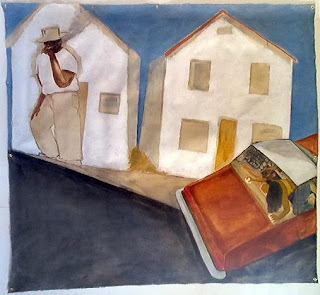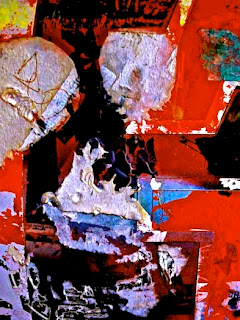KAMOINGE:
A Brief History
Kamoinge,
Inc. was founded as a collective of African-American photographers seeking
artistic equality and empowerment. It works as a forum in which members view,
nurture, critique and challenge each other’s work in an honest and
understanding atmosphere. In 1963, two groups of New York based, African
American photographers held a joint meeting. One group was Group 35, which
included James Ray Francis, Adger W. Cowans, Louis Draper, Herman Howard, Earl
James and Calvin Mercer. The other group included Herbert Randall, Albert
Fennar, Shawn Walker, and James Mannas. Out of this meeting came the Kamoinge
Workshop. The name derives from the Gikuyu language of Kenya and means ‘a group
of people acting together.’
Photographers Roy DeCarava, Larry Stewart and Melvin Mills were
important catalysts for the group’s early development with DeCarava, a
philosophical and artistic innovator, voted the first director of Kamoinge.
In
1965, the group opened the Kamoinge Gallery in a brownstone on West 137th
Street. The activities in the new space included numerous group exhibitions,
rigorous and constructive critiques of photographs and portfolios, frequent
visitors and guest speakers. Early guests included: Peter Magubane, a
photojournalist from South Africa; John Szarkowski, Director of Photography at
the Museum of Modern Art; Langston Hughes, playwright and Poet Laureate of
Harlem (who was a guest at a few Kamoinge meetings); Henri Cartier-Bresson, the
important French photojournalist; and R. E. Martinez, publisher of Camera, an influential Swiss photo magazine. Since the
founding of Kamoinge, its members have participated in hundreds of individual
and group exhibitions in major national and international artistic institutions
too numerous to name. Kamoinge members have published scores of photographic
books and portfolios, all concerned with the truth, insight and integrity of
both the subject and artistic process.
Kamoinge
is the most longstanding group of creative professional photographers existing
in America to date.
Based
in New York City, Kamoinge has met continuously since 1963 under the leadership
of creative and active directors including Anthony Barboza, Roy DeCarava, Louis
Draper and Beuford Smith. Individually, the members lecture, conduct seminars,
teach in universities and work in fine art photography, commercial photography,
motion pictures, and video. Current active members include Salimah Ali, Anthony
Barboza (President), Mark Lee Blackshear, Spencer Burnett, Adger W. Cowans (Vice-President),
Gerald Cyrus, C. Daniel Dawson, Albert Fennar, Collette V. Fournier, Russell K.
Frederick, Ronald Herard, Toni Parks, John Pinderhughes, Herb Randall, Eli
Reed, Herb Robinson (Treasurer), Radcliffe Roye, Darryl Sivad, Ming Smith
Murray, Frank Stewart, June Truesdale, Shawn Walker and Budd Williams. The
current portfolios and projects of Kamoinge members can be viewed at www.kamoinge.com.
Herb Robinson has been documenting the human experience as a
New York based photographer for over 40 years. From early on, the great Roy De
Carava was a seminal influence that encouraged him in his work. Herb also
studied and absorbed the work of such painters as Chardin and Vermeer who
influenced his composition and use of light. Music - jazz in
particular - has been an important influence on Herb's working style.
ADGER COWANS
" THE MAKING OF IMAGES IS TRANSFORMATIVE FOR THE ARTIST AND THE VIEWER.... "
SHAWN WALKER
PAINTING WITH LIGHT: PHOTOGRAPHIC EXPLORATIONS OF WALLS,
SIDEWALKS AND STREETS
Coming from the urban realism of The Ashcan School, my newest portfolio
works to move my inner vision of the world around me into reality; to make
the invisible visible. I seek to reveal what is usually hidden - to manifest
rather than to create. Following from the Be-Bop artists like Monk, Bird and
Miles, from the works of Fellini and Antonioni, and from the cubists and
abstract expressionists, I am developing a surrealist modernist view drawn
from an African aesthetic, advancing the legacy of Romare Bearden,
Charles White and Jacob Lawrence.
Here the walls, sidewalks and streets themselves are the subject matter, as
they reveal the spirits within; the spirits that called to our ancestors to
create the traditional rituals that I celebrate in my earlier work. I see myself
not as religious but as spiritualist. My large collection of African
masks/”primitive” objects and my study and knowledge of the Black/African
aesthetic provided the impetus for this series.
Other photographs within the series harken to the universe, to exploding
stars and super novas. These move inward towards neutrons and protons
and outward towards galaxies. In the tradition of the Dogon who first
recognized and incorporated the movement and significance of the stars
into their everyday lives, I am trying to connect the spiritual with the
concrete, looking at the concealed universes around us.
The magic of photography allows the photographer to give voice to his
alchemist self. This series uses light to give rise to the painter within the
photographer. Consistent with my previous work, however, all of these
images are “found images”. They are not digitally created or re-organized,
only enhanced. They pull through the multi-layering within the existing
reality to reveal the significance within the common place. The viewers
must interact with these shapes and colors to find their own interpretation
of what exists: to find, if you wish, their own spirits.
I see part of my responsibility as a photographic artist to broaden the
perspective of our craft to present views of the world others might not have
seen or considered. I am trying to move my art form forward.
BE-BOP/IMPROVISATIONS
These images reflect my work as a photo-journalist/street photographer, as I give
expression to my more surrealist fine-art voice. These are all analog images that have
been “found” – neither computer generated or enhanced nor super-impositions done
in the darkroom. I am attempting to document the “parallel universes” that we
confront every day but often do not see.
The series deals with reflective surfaces. I am interested in the multi-layering of
collage art and how the interplay of the layers influences the interpretation of their
individual meaning and the viewer’s understanding of the whole image. I am
attempting to emulate what the classical be-bop musicians like Bird, Diz, Monk,
Trane and Miles did: taking basic, common themes and re-working them/improvising
on them.
I am presenting visual images in new rhythmic and harmonic formulations,
improvising with how many layers I capture. My multi-dimensional images include
glass, the background within it, the focal plane and planes behind the camera.
Sometimes one or more of these planes have additional reflected elements that
multiply the complexity. They incorporate both an image and a process, with a 2-D
perspective that follows into the distance and an enhanced 3-D dimensionality. The
viewer adds the final dimension in this process – as (s)he brings a personal
interaction with all of these elements, resolves the initial confusion and sees the
common-place in a new way.
A master black-and-white printer, I started to work in sepia in the 1970’s*. Sepia
gave additional depth when photographing people of color, and the warm tones
provided another element in my visual statements, giving me a new excitement about
my work. When I lost access to my darkroom and moved to commercial processing, I
found that using a dye-silver process film (Kodak C-41) on color paper gave me a
sepia option that further enhanced the project.
Be-Bop/Improvisation is one of my on-going projects.
*My first sepia portfolio was completed in 1978, after working with Agfa Portriga-
Rapid in the 1960’s and selenium toning, exploring the richness/benefit to my
portraiture work.
73x92+in.,oil&mixed+media+on+canvas+2003+ALUGAS.jpg)

,+73x62+in.,+oil+on+canvas,+2003,+ALUGAS.jpg)


+73x83in+oil+on+canvas+2000+ALUGAS.jpg)
,86_x+72_oil+&+mixed+media+on+canvas+1996+ALUGAS.jpg)
+103+x+54+in.+acrylic+&+mixed+media+on+plastic+2006+ALUGAS+72dpi.jpg)











































